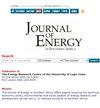确定南非液体和气体燃料的国别温室气体排放系数
IF 0.6
4区 工程技术
Q4 ENERGY & FUELS
引用次数: 1
摘要
温室气体报告的高级方法要求固定和移动燃料燃烧活动的一系列液体和气体燃料的国别特定排放因子。夏季和冬季在南非豪登省、姆普马兰加省、自由邦、夸祖鲁-纳塔尔省和西开普省收集了南非使用的选定液体燃料样本,主要来自主要交通路线沿线的大型零售站(无铅汽油- ULP93和ULP95 -和柴油)。还在适当地点取样了体积较小的液体燃料(生物乙醇、石蜡、航空煤油、航空汽油和重质燃料油)。样本(共343份)在认可的商业实验室使用标准方法分析碳含量。还确定了燃料的热值,以便计算甲烷和一氧化二氮的排放系数。对结果进行统计分析,以确定平均值及其不确定性,识别异常值,并确定变量之间的相关性。ULP93和ULP95的结果以各自2021年的年平均销量加权,得到所有汽油的平均值为2263 g CO2/L。根据2018-2021年的销售数据,对夏季和冬季的结果进行等量加权,得到ULP93 (2255 g CO2/L)、ULP95 (2265 g CO2/L)和柴油(2650 g CO2/L)的年平均排放系数,反映出与2017年环境事务部监测、报告和核查行业温室气体排放的技术指南中包含的值相比略有下降。基于计算的液化石油气排放系数,经一些当地供应商的分析证书确认,发现为3002克二氧化碳/公斤。本文章由计算机程序翻译,如有差异,请以英文原文为准。
Determination of country-specific greenhouse gas emission factors for South African liquid and gaseous fuels
Higher-tier methods for greenhouse gas reporting require country-specific emission factors for a range of liquid and gaseous fuels for both stationary and mobile fuel combustion activities. Samples of selected liquid fuels used in South Africa were collected over the summer and winter seasons in the Gauteng, Mpumalanga, Free State, KwaZulu-Natal and Western Cape provinces of South Africa, primarily from large retail stations along major traffic routes (unleaded petrol – ULP93 and ULP95 – and diesel). Liquid fuels used in smaller volumes (bio-ethanol, paraffin, jet kerosene, aviation gasoline and heavy fuel oil) were also sampled at appropriate locations. Samples (343 in total) were analysed for carbon content using standard methods at an accredited commercial laboratory. Calorific values of the fuels were also determined, to allow for the calculation of methane and nitrous oxide emission factors. Results were statistically analysed to determine mean values and their uncertainties, to identify outliers, and to determine correlations between variables. Results for ULP93 and ULP95 were weighted by their respective 2021 annual average sales volumes to obtain an average value for all petrol of 2 263 g CO2/L. Based on sales data from the years 2018–2021, summer and winter results were equally weighted to obtain annual average emission factors for ULP93 (2255 g CO2/L), ULP95 (2 265 g CO2/L) and diesel (2 650 g CO2/L), reflecting a slight decrease from the values contained in the 2017 Department of Environmental Affairs Technical guidelines for monitoring, reporting and verification of greenhouse gas emissions by industry. A calculation-based liquefied petroleum gas emission factor, confirmed by analysis certificates from a number of local suppliers, was found to be 3002 g CO2/kg.
求助全文
通过发布文献求助,成功后即可免费获取论文全文。
去求助
来源期刊

Journal of Energy in Southern Africa
ENERGY & FUELS-
CiteScore
3.00
自引率
0.00%
发文量
16
审稿时长
6 months
期刊介绍:
The journal has a regional focus on southern Africa. Manuscripts that are accepted for consideration to publish in the journal must address energy issues in southern Africa or have a clear component relevant to southern Africa, including research that was set-up or designed in the region. The southern African region is considered to be constituted by the following fifteen (15) countries: Angola, Botswana, Democratic Republic of Congo, Lesotho, Malawi, Madagascar, Mauritius, Mozambique, Namibia, Seychelles, South Africa, Swaziland, Tanzania, Zambia and Zimbabwe.
Within this broad field of energy research, topics of particular interest include energy efficiency, modelling, renewable energy, poverty, sustainable development, climate change mitigation, energy security, energy policy, energy governance, markets, technology and innovation.
 求助内容:
求助内容: 应助结果提醒方式:
应助结果提醒方式:


